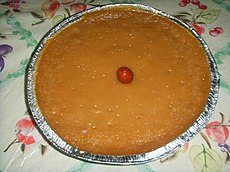Nian gao

Cantonese-style nian gao
|
|
| Alternative names | Year cake, Chinese New Year's cake, tikoy, ti kuih |
|---|---|
| Place of origin | China |
| Region or state | Chinese-speaking areas |
| Variations | Varies by region (Cantonese, Shanghai, Fujian, etc.) |
| Other information | Typically consumed during Chinese New Year |
| |
|
| Nian gao | |||||||||||||||
| Chinese | 年糕 | ||||||||||||||
|---|---|---|---|---|---|---|---|---|---|---|---|---|---|---|---|
| Literal meaning | year cake | ||||||||||||||
|
|||||||||||||||
| Alternative Chinese name | |||||||||||||||
| Chinese | 甜粿 | ||||||||||||||
| Literal meaning | sweet kuih | ||||||||||||||
|
|||||||||||||||
| Transcriptions | |
|---|---|
| Standard Mandarin | |
| Hanyu Pinyin | niángāo |
| Wu | |
| Romanization | [ɲi kɔ] |
| Yue: Cantonese | |
| Jyutping | nin4 gou1 |
| Transcriptions | |
|---|---|
| Southern Min | |
| Hokkien POJ | tiⁿ-kóe or tiⁿ-ké |
Nian gao (also niangao; nin gou in Cantonese), sometimes translated as year cake or Chinese New Year's cake, is a food prepared from glutinous rice and consumed in Chinese cuisine. While it can be eaten all year round, traditionally it is most popular during Chinese New Year. It is also traditionally eaten during the Duanwu Festival. It is considered good luck to eat nian gao during this time, because nian gao is a homonym for "higher year." The Chinese word 粘 (nián), meaning "sticky", is identical in sound to 年, meaning "year", and the word 糕 (gāo), meaning "cake" is identical in sound to 高, meaning "high or tall". As such, eating nian gao has the symbolism of raising oneself taller in each coming year (年年高升 niánnián gāoshēng). It is also known as a rice cake. This sticky sweet snack was believed to be an offering to the Kitchen God, with the aim that his mouth will be stuck with the sticky cake, so that he can't badmouth the human family in front of the Jade Emperor.
Nian gao sounds identical to 年高 implying promotions or prosperity year after year. This association makes nian gao a popular gift item during the New Year period.
On the more human level, nian gao are popular as gifts during the Chinese New Year. The traditional nian gao is round with an auspicious decoration such as the character for prosperity (福) on its top. The character is often written in the traditional Chinese script.
As a gift item, nian gao are fashioned into different shapes with attractive packaging to suit the festive season. Popular designs include a pair of carps (年年有餘) symbolizing surplus every year, ingots (元寶), or the God of Wealth 財神. These designs are auspicious symbols and send good wishes for the New Year.
Some innovative producers have added a scratch area for consumers to reveal a lucky number for lottery bets. The production, sales and consumption of nian gao is another evidence of food as a transmission medium for social aspirations and how it can be shaped, packaged and promoted in varying forms to resonate with consumer’s social dreams.
Despite numerous varieties, they all share the same glutinous rice ingredient that is pounded or ground into a paste and, depending on the variety, may simply be molded into shape or cooked again to settle the ingredient. nian gao has many varieties including the types found in Shanghai cuisine, Fujian cuisine and Cantonese cuisine originating from Guangdong.
...
Wikipedia
